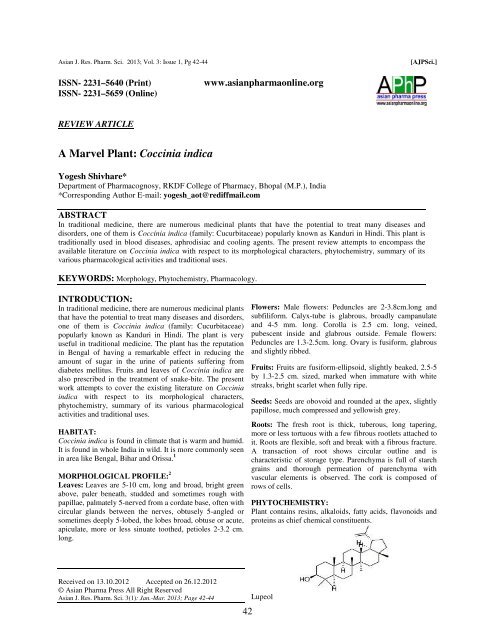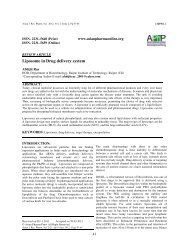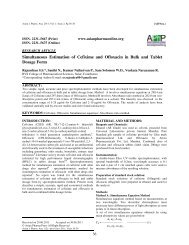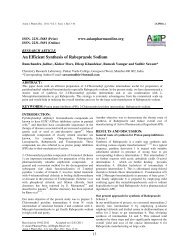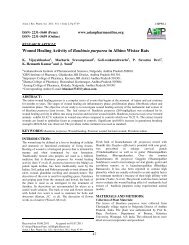Download PDF - asian pharma press
Download PDF - asian pharma press
Download PDF - asian pharma press
You also want an ePaper? Increase the reach of your titles
YUMPU automatically turns print PDFs into web optimized ePapers that Google loves.
Asian J. Res. Pharm. Sci. 2013; Vol. 3: Issue 1, Pg 42-44<br />
[AJPSci.]<br />
ISSN- 2231–5640 (Print)<br />
ISSN- 2231–5659 (Online)<br />
www.<strong>asian</strong><strong>pharma</strong>online.org<br />
REVIEW ARTICLE<br />
A Marvel Plant: Coccinia indica<br />
Yogesh Shivhare*<br />
Department of Pharmacognosy, RKDF College of Pharmacy, Bhopal (M.P.), India<br />
*Corresponding Author E-mail: yogesh_aot@rediffmail.com<br />
ABSTRACT<br />
In traditional medicine, there are numerous medicinal plants that have the potential to treat many diseases and<br />
disorders, one of them is Coccinia indica (family: Cucurbitaceae) popularly known as Kanduri in Hindi. This plant is<br />
traditionally used in blood diseases, aphrodisiac and cooling agents. The present review attempts to encompass the<br />
available literature on Coccinia indica with respect to its morphological characters, phytochemistry, summary of its<br />
various <strong>pharma</strong>cological activities and traditional uses.<br />
KEYWORDS: Morphology, Phytochemistry, Pharmacology.<br />
INTRODUCTION:<br />
In traditional medicine, there are numerous medicinal plants<br />
that have the potential to treat many diseases and disorders,<br />
one of them is Coccinia indica (family: Cucurbitaceae)<br />
popularly known as Kanduri in Hindi. The plant is very<br />
useful in traditional medicine. The plant has the reputation<br />
in Bengal of having a remarkable effect in reducing the<br />
amount of sugar in the urine of patients suffering from<br />
diabetes mellitus. Fruits and leaves of Coccinia indica are<br />
also prescribed in the treatment of snake-bite. The present<br />
work attempts to cover the existing literature on Coccinia<br />
indica with respect to its morphological characters,<br />
phytochemistry, summary of its various <strong>pharma</strong>cological<br />
activities and traditional uses.<br />
HABITAT:<br />
Coccinia indica is found in climate that is warm and humid.<br />
It is found in whole India in wild. It is more commonly seen<br />
in area like Bengal, Bihar and Orissa. 1<br />
MORPHOLOGICAL PROFILE: 2<br />
Leaves: Leaves are 5-10 cm, long and broad, bright green<br />
above, paler beneath, studded and sometimes rough with<br />
papillae, palmately 5-nerved from a cordate base, often with<br />
circular glands between the nerves, obtusely 5-angled or<br />
sometimes deeply 5-lobed, the lobes broad, obtuse or acute,<br />
apiculate, more or less sinuate toothed, petioles 2-3.2 cm.<br />
long.<br />
Flowers: Male flowers: Peduncles are 2-3.8cm.long and<br />
subfiliform. Calyx-tube is glabrous, broadly campanulate<br />
and 4-5 mm. long. Corolla is 2.5 cm. long, veined,<br />
pubescent inside and glabrous outside. Female flowers:<br />
Peduncles are 1.3-2.5cm. long. Ovary is fusiform, glabrous<br />
and slightly ribbed.<br />
Fruits: Fruits are fusiform-ellipsoid, slightly beaked, 2.5-5<br />
by 1.3-2.5 cm. sized, marked when immature with white<br />
streaks, bright scarlet when fully ripe.<br />
Seeds: Seeds are obovoid and rounded at the apex, slightly<br />
papillose, much com<strong>press</strong>ed and yellowish grey.<br />
Roots: The fresh root is thick, tuberous, long tapering,<br />
more or less tortuous with a few fibrous rootlets attached to<br />
it. Roots are flexible, soft and break with a fibrous fracture.<br />
A transaction of root shows circular outline and is<br />
characteristic of storage type. Parenchyma is full of starch<br />
grains and thorough permeation of parenchyma with<br />
vascular elements is observed. The cork is composed of<br />
rows of cells.<br />
PHYTOCHEMISTRY:<br />
Plant contains resins, alkaloids, fatty acids, flavonoids and<br />
proteins as chief chemical constituents.<br />
Received on 13.10.2012 Accepted on 26.12.2012<br />
© Asian Pharma Press All Right Reserved<br />
Asian J. Res. Pharm. Sci. 3(1): Jan.-Mar. 2013; Page 42-44<br />
42<br />
Lupeol
Asian J. Res. Pharm. Sci. 2013; Vol. 3: Issue 1, Pg 42-44<br />
Palmitic acid<br />
[AJPSci.]<br />
Anti-inflammatory, Analgesic and Antipyretic activity<br />
Aqueous extract of Coccinia indica (leaves) produced<br />
marked analgesic and antipyretic activity at 300mg/kg dose<br />
when compared with standard drugs (Morphine and<br />
Paracetamol). The extract also showed significant antiinflammatory<br />
activity. 5 (Junaid Niazi et al )<br />
Antimicrobial activity<br />
Petroleum ether and methanolic extract of Coccinia indica<br />
showed the highest antimicrobial activity against grampositive<br />
organisms. 6<br />
Oleic Acid<br />
Antibacterial Activity<br />
Ethanol and aqueous extracts of Coccinia indica showed<br />
promising antibacterial activity against the Enterobacter<br />
aerogenes, Pseudomonas aeruginosa, Staphylococcus<br />
epidermidis, Bacillus subtilis and Salmonella typhimurium<br />
by agar well diffusion method and broth dilution method. 7<br />
Linoleic Acid<br />
Antihyperglycemic activity<br />
Chronic administration of Coccinia Indica (fruits) extract at<br />
dose of 200mg/kg for 14 days reduces the blood glucose<br />
level of the diabetes induced animals as compared to<br />
diabetic control group. 8<br />
Hepatoproetcective activity<br />
Coccinia indica leave extract at dose 400 mg/kg body<br />
weight showed potent hepatoproetcective activity in albino<br />
rats. 9<br />
Riboflavin<br />
TRADITIONAL USES:<br />
The fruit of Coccinia indica is useful in biliousness and<br />
diseases of blood. The green fruit is chewed to cure sores<br />
on the tongue. The bark of root is used as cathartic. The<br />
leaves are applied externally in eruptions of the skin. The<br />
leaves of this plant are boiled in gingelly oil and applied<br />
externally in ringworm, psoriasis and itch. The leaves are<br />
also used as expectorant and antispasmodic. The oil is used<br />
in application to ulcers and as an injection into chronic<br />
sinuses. The plant is also used in the treatment of<br />
gonorrhea.<br />
Taraxerol<br />
PHARMACOLOGICAL PROFILE:<br />
Anthelmintic Activity<br />
Methanol extract of Coccinia indica fruits in the<br />
concentration of 50 mg/ml showed potent anthelmintic<br />
activity against Pheretima posthuma. 3<br />
Antioxidant activity<br />
Oral administration of ethanolic extract of Coccinia indica<br />
(leaf) extract (CLEt) (200 mg/kg body weight) for 45 days<br />
resulted in a significant reduction in thiobarbituric acid<br />
reactive substances and hydroperoxides in rats. 4<br />
Table 1 Vernacular names of Coccinia indica<br />
S.N. Names Language<br />
1 Kanduri Hindi<br />
2 Bimbu Bengal<br />
3 Galedu Gujerati<br />
4 Bimbi Marathi<br />
5 Kundru Punjab<br />
6 Bimbaka Sanskrit<br />
7 Kovai Tamil<br />
8 Kundaru Urdu<br />
Table 2 Scientific Classification<br />
Kingdom Plantae<br />
Division Magnoliophyta<br />
Class<br />
Magnoliophyta<br />
Order Cucurbitales<br />
Family Cucurbitaceae<br />
Genus Coccinia<br />
Species Indica<br />
43
Asian J. Res. Pharm. Sci. 2013; Vol. 3: Issue 1, Pg 42-44<br />
[AJPSci.]<br />
CONCLUSION:<br />
Now a day’s major concern of researchers is focused on the<br />
development of new novel herbal drugs that could be useful<br />
in the treatment of various disease problems. This versatile<br />
medicinal plant is the distinctive source of various types of<br />
chemical compounds, which are accountable of the various<br />
activities of the plant. Hence, extensive exploration is<br />
required to utilize their therapeutic efficacy to combat<br />
diseases.<br />
ACKNOWLEDGEMENT:<br />
Yogesh Shivhare, the author, thankfully acknowledges to<br />
Mr. Rakesh Punekar, Head and Vice-Principal, RKDF<br />
College of Pharmacy, Bhopal (M.P.), in preparation of this<br />
manuscript.<br />
REFERENCE:<br />
1. www.ayushveda.com<br />
2. Kirtikar KR, Basu BD. Indian Medicinal Plant. 1976: Vol. II, M/s<br />
Bishwas Singh, Nirali prakasan, Dehradun, 1151-1154.<br />
3. Shivhare Yogesh, Soni Prashant, Singh Priya, Dangi Sonal and<br />
Baghel S Sourabh. Evaluation of Anthelmintic Activity of<br />
Coccinia indica (fruits). J. Chem. Pharm. Res., 2011: 3(1); 488-<br />
491<br />
4. Venkateswaran S and Pari L.. Effect of Coccinia indica leaves on<br />
antioxidant status in streptozotocin-induced diabetic rats. Journal<br />
of ethano<strong>pharma</strong>cology. 2003: vol 84, issue 2, 163-168.<br />
5. Niazi Junaid, Singh Parabhdeep and Bansal Yogita. Antiinflammatory,<br />
Analgesic and Antipyretic activity of aqueous<br />
extract of fresh leaves of Coccinia indica.<br />
Inflammo<strong>pharma</strong>cology. 2009: 17: 239-244.<br />
6. Syed Zeenat Shaheen, Bolla Krishna, Kandukuri vasu and<br />
Singara Charya MA. Antimicrobial activity of the fruit extracts of<br />
Coccinia indica. African Journal of Biotechnology. 2009: Vol. 8<br />
(24); 7073-7076.<br />
7. Hussain Arshad, Wahab Shadma, Zarin Iffat and Sarfaraj Hussain<br />
MD. Antibacterial Activity of the Leaves of Coccinia indica (W.<br />
and A) Wof India. Advances in Biological Research. 2010: 4 (5):<br />
241-248.<br />
8. Gunjan Manish, Jana K Goutam, Jha AK and Mishra<br />
Umashanker. Pharmacognsotic and Antihyperglycemic study of<br />
Coccinia indica. International Journal of Phytomedicine. 2010: 2;<br />
36-40.<br />
9. Kumar B. Shyam, D. Gnanasekaran V, Jaishree KP and<br />
Channabasavaraj. Hepatoprotective activity of Coccinia indica<br />
leaves extract. Int J Pharm Biomed Res 2010, 1(4), 154-156.<br />
44


